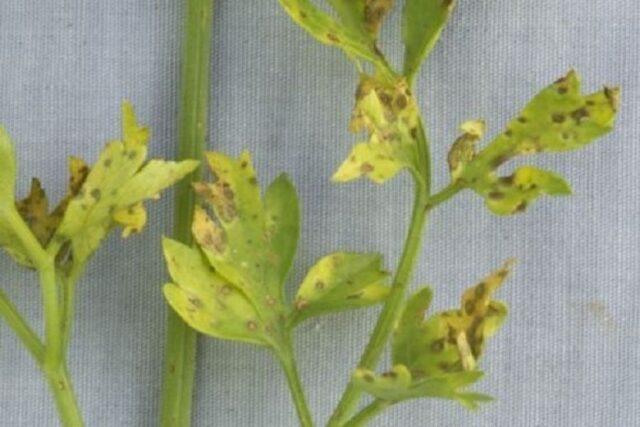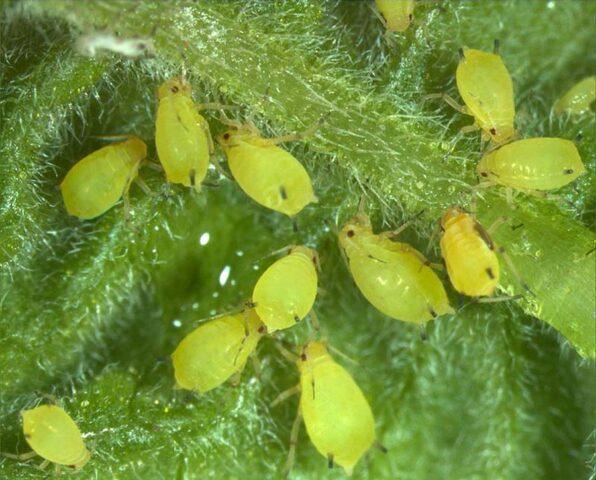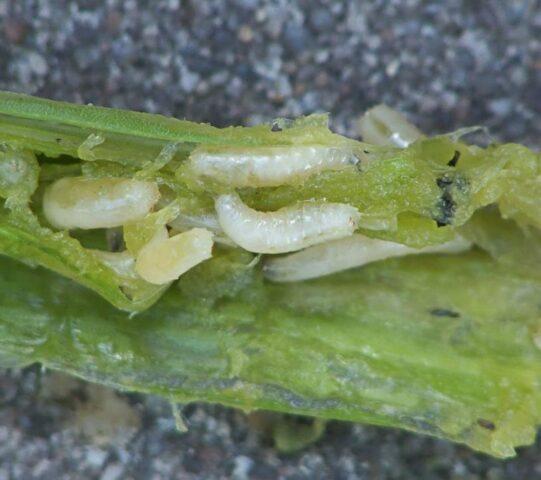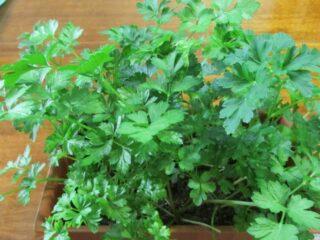Content
Diseases and pests of parsley can significantly reduce crop yields. In order to begin treatment of plantings in a timely manner, it is first necessary to study the main symptoms.
Parsley diseases and their treatment
Parsley diseases can be divided into two categories:
- fungal - most often appear on poor soil and with insufficient care;
- viral - diseases are carried by insects; infection can also occur in close proximity to other plants.
Many parsley diseases respond well to treatment in the early stages. In order to start spraying the plantings on time, it is necessary to regularly inspect the bushes for rotting stems or spots on the leaves.
Powdery mildew
Photos of leaf parsley disease show that a dry white-gray coating appears on the plant in the first stages. First, the lower plates suffer, then the disease spreads higher. At the same time, the plaque darkens, becomes brownish-brown and thickens, the leaves begin to dry out and fall off.

Powdery mildew affects parsley in hot, dry weather and when there is excess nitrogen in the soil.
Powdery mildew spreads quickly from plant to plant and can cause serious damage to crop yields. When a characteristic plaque appears, the affected bushes must be removed. The remaining plantings are sprayed with Quadris or copper sulfate for preventive purposes.
Rust
The fungal disease appears as raised yellow-brown spots on the lower leaves. Rust symptoms first appear in early summer; by autumn the marks darken, cover the entire plant and merge with each other. Parsley begins to dry out and fade.
Rust is especially dangerous because its spores overwinter well in plant debris and can infect new plantings. If a disease is detected, it is necessary to eliminate the affected parsley from the area and treat the neighboring bushes with Fundazol. With the onset of autumn, it is important to remove all debris from the beds and loosen the soil to prevent the fungus from reappearing.

Parsley rust usually develops in damp but fairly cool weather.
Fomoz
A fungal disease develops on parsley at a temperature of about 15 ° C and with high humidity. Leaves gray-brown spots on leaf veins. If you dig up parsley, you will find depressed rotten areas on its roots.

Parsley infected with Phoma becomes especially attractive to pests
The fight against fungus in the early stages is carried out using copper sulfate, Bordeaux mixture or the preparations Fundazol and Quadris.To prevent the disease, it is recommended to treat planting material in a light pink solution of potassium permanganate and follow the rules of crop rotation.
Stolbur
Phytoplasma disease of parsley can be recognized by the redness of the leaves. First, a dark, bright rim appears along the edge, and then the entire plate changes color. Parsley becomes unsuitable for food consumption; the emerging seeds cannot be used for propagation of the crop. Under the influence of stolbur, the plant dries out and eventually dies.

Stolbur especially often affects parsley at the end of summer, and the disease is carried by cicadas
It is almost impossible to cure plantings affected by phytoplasmosis. The control is carried out in a preventive manner - the seeds are treated, weeds are pulled out in the beds and the bushes are not allowed to thicken. Since stolbur is carried by insects, it is necessary to protect the plant from pests.
Black rot (Alternaria blight)
A fungal disease affects parsley root crops, which become covered with black spots. In some cases, the disease rises up the stem. The taste of the greenery noticeably deteriorates, the root system begins to separate, and the bushes die.

Greens affected by Alternaria quickly turn black
Since the disease develops mainly underground, it is very difficult to cure the crop in time. Usually, the affected bushes are simply removed, the remaining plants are sprayed with fungicidal preparations and the intensity of watering is reduced. Prevention of Alternaria is the use of high-quality planting material.To prevent root crops from being damaged by the disease after harvesting, they should be stored in a dry, dark room at a low temperature.
Septoria (white spot)
White spot can be recognized by small light marks with a dark rim on the leaf blades of the plant. Gradually they spread throughout the bush, darken and turn brownish, and the crop eventually dries out.

Septoria usually appears at the end of summer in warm weather; fungal spores are spread by wind and rain
When sick, parsley should be sprayed with systemic fungicides. The best prevention of white spotting is to sow high-quality disinfected seeds on neutral or slightly alkaline soils. To prevent fungal spores from overwintering in plant debris, in the fall all debris is removed from the beds and the soil is thoroughly dug up.
Variegated dwarfism
Parsley disease is viral in origin and is spread by harmful insects. The leaves of the plant decrease in size and become deformed, turning pale and yellow at the edges.
It is impossible to cure variegated dwarfism, but regular weeding of the beds is a good way to prevent the virus. For protective purposes, the crop is treated with Bordeaux mixture and insecticides to increase immunity and eliminate insects.

Variegated dwarfism of parsley provokes crop degeneration
Jaundice
Another viral disease causes the leaves of the crop to quickly turn yellow, and the stems become deformed and begin to bristle in different directions. The bushes become like sloppy brooms. The taste and benefits of greens are greatly reduced.

To prevent jaundice, it is recommended to grow varieties resistant to the viral disease
When symptoms of jaundice appear, affected parsley must be removed from the garden. Neighboring plants can be sprayed with Bordeaux mixture or copper sulfate - these products do not treat the virus, but protect the bushes prophylactically.
Parsley pests and their control
Parsley in the garden suffers not only from diseases, but also from parasitic insects. Pests begin to feed on the plant in early spring and can completely destroy the crop.
melon aphid
The melon aphid is a very small insect with an egg-shaped black or green body. It reproduces in huge colonies and poses a great threat to crops because it sucks plant sap from it.
You can get rid of aphids on parsley in the first stages by spraying with a soap solution or infusion of onion peels. To prevent the pest, it is recommended to plant the crop in well-ventilated areas and periodically thin out the bushes. Aphids on parsley should be controlled with chemicals only if they are severely infested. Insecticides are good at killing pests, but can also kill beneficial insects.

The melon aphid lays eggs on parsley every two weeks throughout the season.
carrot fly
A small black insect with a reddish head and transparent wings reaches only 5 mm in length. It damages parsley both at the larval stage and in adulthood; it feeds on the stems and leaves of the crop. As a result, the latter become covered with small ulcers and change their hue to dark purple.
You can get rid of carrot flies using the drugs Aktara, Arrivo and Fitoverm. Among folk remedies, onion, garlic and tomato infusions have a good effect.

The carrot fly begins to harm parsley in mid-May
Stem nematode
Nematodes, which are long thread-like worms, appear on parsley in early summer. Under the influence of the pest, thickenings form on the stem of the crop, the shoot becomes bent and stops growing, and chaotic stripes and spots appear on the leaves.
It is impossible to save bushes affected by stem nematode, so they are simply destroyed. Healthy plants are treated with HOM to prevent the pest.

The stem nematode is difficult to recognize in its early stages due to the fact that it lives inside the stem
carrot psyllid
The insect does not exceed 2 mm in length, has a yellowish-green body, membranous wings and large red eyes. It feeds on parsley juice and slows down its development, the leaves of the crop curl, and the root hardens, dries and gradually collapses.
Pest control is carried out using the drugs Tsimbush and Actellik. If the damage is mild, you can treat the plantings with a homemade soap and tobacco solution. When using chemicals for treatment, you must stop spraying no later than a month before harvesting greens or fruits.

To protect against carrot flea beetle, parsley should be planted away from coniferous trees and wild carrots.
Preventive measures
Some diseases and pests of parsley are difficult to eliminate.Therefore, special attention must be paid to prevention - it greatly facilitates crop care:
- Before planting, the seeds of the plant should be treated with a light pink solution of potassium permanganate. The product reliably kills microorganisms and fungal spores, and also increases the immunity of parsley.
- When growing crops, crop rotation must be observed. Parsley should not be planted in the ground after carrots, and it is also not recommended to sow it in one place for two years in a row. It is best to place the crop where cucumbers, tomatoes or berries used to grow.
- Parsley diseases can be prevented by following proper agricultural practices. The bushes need to be watered only when the soil dries out, so as not to provoke waterlogging of the soil. After adding moisture, the soil is loosened to improve oxygen access to the roots.
When growing parsley in a greenhouse, you must follow the same prevention rules as in open ground. The air temperature in the greenhouse should not exceed 20-23 °C; plantings must be regularly ventilated to avoid excessive humidity.
Conclusion
Diseases and pests of parsley can seriously deteriorate the nutritional quality of the plant and even completely destroy the crop. When growing a crop, you need to regularly inspect the plantings and immediately begin treatment if suspicious spots, holes or deformations are detected on the leaves.








